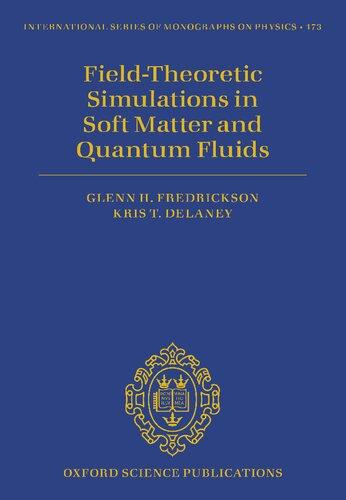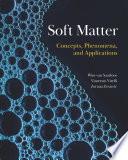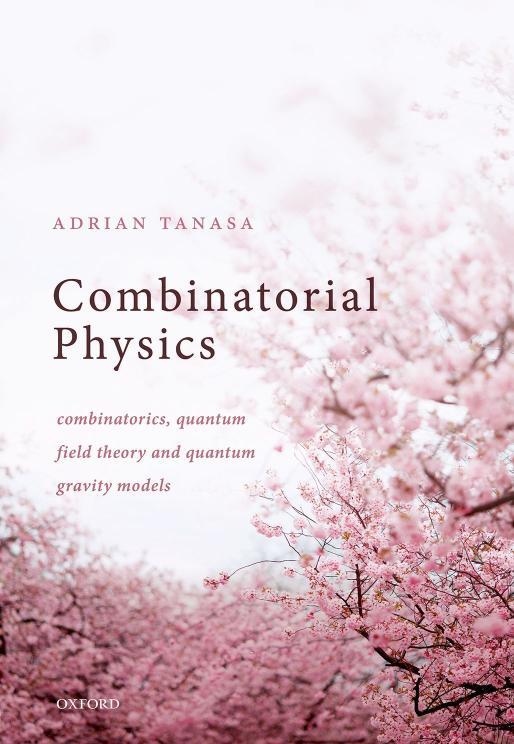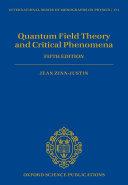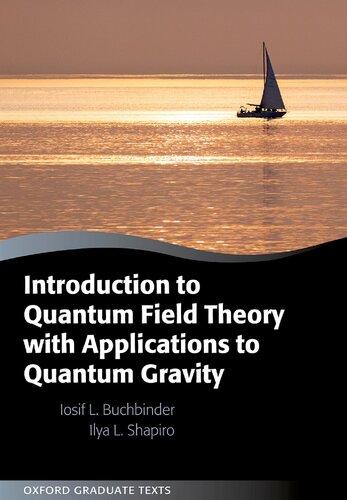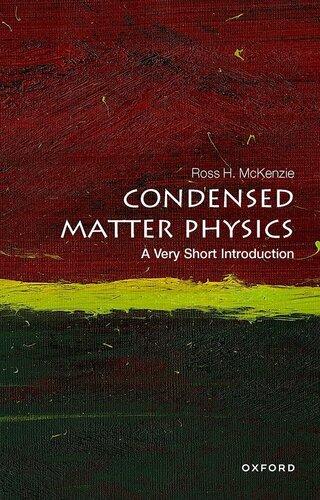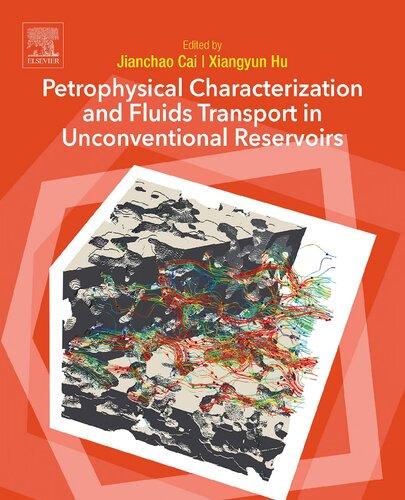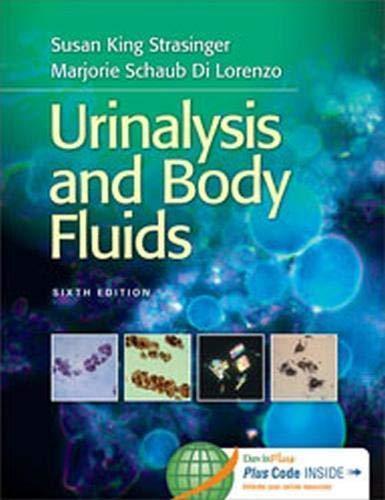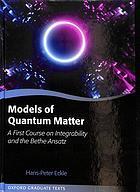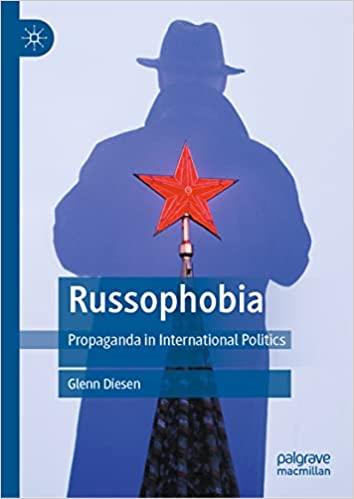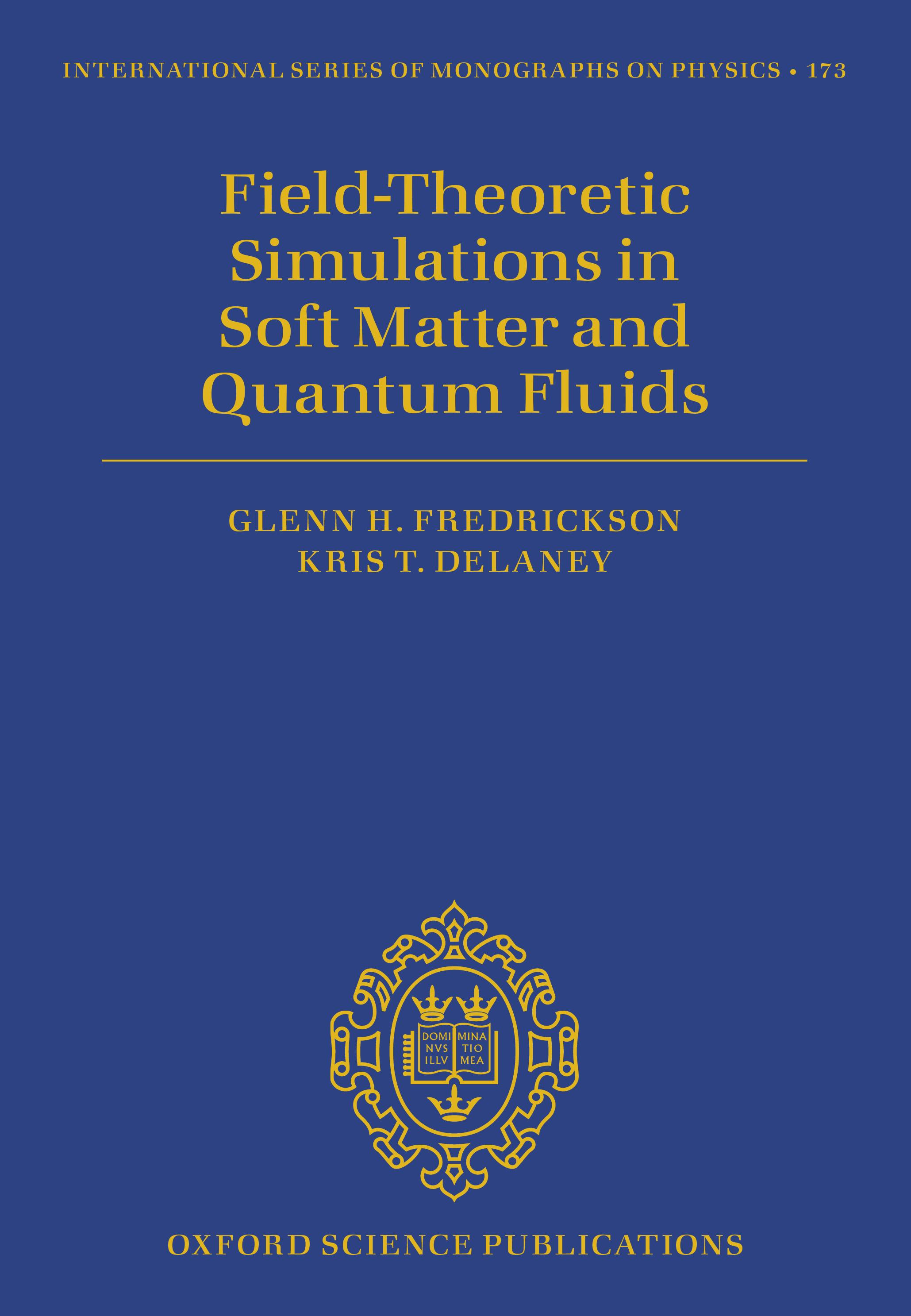Visit to download the full and correct content document: https://ebookmass.com/product/field-theoretic-simulations-in-soft-matter-and-quantum -fluids-glenn-h-fredrickson/
More products digital (pdf, epub, mobi) instant download maybe you interests ...
Soft Matter: Concepts, Phenomena, and Applications Wim Van Saarloos
https://ebookmass.com/product/soft-matter-concepts-phenomena-andapplications-wim-van-saarloos/
Combinatorial Physics: Combinatorics, Quantum Field Theory, and Quantum Gravity Models Adrian Tanasa
https://ebookmass.com/product/combinatorial-physicscombinatorics-quantum-field-theory-and-quantum-gravity-modelsadrian-tanasa/
Quantum Field Theory and Critical Phenomena 5th Edition Jean Zinn-Justin
https://ebookmass.com/product/quantum-field-theory-and-criticalphenomena-5th-edition-jean-zinn-justin/
Introduction to Quantum Field Theory with Applications to Quantum Gravity 1st Edition Iosif L. Buchbinder
https://ebookmass.com/product/introduction-to-quantum-fieldtheory-with-applications-to-quantum-gravity-1st-edition-iosif-lbuchbinder/
Condensed Matter Physics: A Very Short Introduction
Ross H. Mckenzie
https://ebookmass.com/product/condensed-matter-physics-a-veryshort-introduction-ross-h-mckenzie/
Petrophysical Characterization and Fluids Transport in Unconventional Reservoirs Jianchao Cai
https://ebookmass.com/product/petrophysical-characterization-andfluids-transport-in-unconventional-reservoirs-jianchao-cai/
Urinalysis and Body Fluids 6th Edition
https://ebookmass.com/product/urinalysis-and-body-fluids-6thedition/
Models of Quantum matter : a first course on integrability and the Bethe Ansatz First Edition. Edition Eckle
https://ebookmass.com/product/models-of-quantum-matter-a-firstcourse-on-integrability-and-the-bethe-ansatz-first-editionedition-eckle/
Russophobia: Propaganda in International Politics Glenn Diesen
https://ebookmass.com/product/russophobia-propaganda-ininternational-politics-glenn-diesen/
Field-TheoreticSimulationsinSoftMatterand QuantumFluids
InternationalSeriesofMonographsonPhysics
SeriesEditors
R.Friend UniversityofCambridge
M.Rees UniversityofCambridge
D.SherringtonUniversityofOxford
G.VenezianoCERN,Geneva
173.G.H.Fredrickson,K.T.Delaney: Field-TheoreticSimulationsinSoftMatterandQuantumFluids
172.J.Kübler: Theoryofitinerantelectronmagnetism,Secondedition
171.J.Zinn-Justin: Quantumfieldtheoryandcriticalphenomena,Fifthedition
170.V.Z.Kresin,S.G.Ovchinnikov,S.A.Wolf: Superconductingstate-mechanismsandmaterials
169.P.T.Chruściel: Geometryofblackholes
168.R.Wigmans: Calorimetry–Energymeasurementinparticlephysics,Secondedition
167.B.Mashhoon: Nonlocalgravity
166.N.Horing: Quantumstatisticalfieldtheory
165.T.C.Choy: Effectivemediumtheory,Secondedition
164.L.Pitaevskii,S.Stringari: Bose-Einsteincondensationandsuperfluidity
163.B.J.Dalton,J.Jeffers,S.M.Barnett: Phasespacemethodsfordegeneratequantumgases
162.W.D.McComb: Homogeneous,isotropicturbulence–phenomenology,renormalizationandstatistical closures
160.C.Barrabès,P.A.Hogan: Advancedgeneralrelativity–gravitywaves,spinningparticles,andblack holes
159.W.Barford: Electronicandopticalpropertiesofconjugatedpolymers,Secondedition
158.F.Strocchi: Anintroductiontonon-perturbativefoundationsofquantumfieldtheory
157.K.H.Bennemann,J.B.Ketterson: Novelsuperfluids,Volume2
156.K.H.Bennemann,J.B.Ketterson: Novelsuperfluids,Volume1
155.C.Kiefer: Quantumgravity,Thirdedition
154.L.Mestel: Stellarmagnetism,Secondedition
153.R.A.Klemm: Layeredsuperconductors,Volume1
152.E.L.Wolf: Principlesofelectrontunnelingspectroscopy,Secondedition 151.R.Blinc: Advancedferroelectricity
150.L.Berthier,G.Biroli,J.-P.Bouchaud,W.vanSaarloos,L.Cipelletti: Dynamicalheterogeneitiesin glasses,colloids,andgranularmedia
149.J.Wesson: Tokamaks,Fourthedition
148.H.Asada,T.Futamase,P.Hogan: Equationsofmotioningeneralrelativity
147.A.Yaouanc,P.DalmasdeRéotier: Muonspinrotation,relaxation,andresonance
146.B.McCoy: Advancedstatisticalmechanics
145.M.Bordag,G.L.Klimchitskaya,U.Mohideen,V.M.Mostepanenko: AdvancesintheCasimireffect
144.T.R.Field: Electromagneticscatteringfromrandommedia
143.W.Götze: Complexdynamicsofglass-formingliquids–amode-couplingtheory
142.V.M.Agranovich: Excitationsinorganicsolids
141.W.T.Grandy: Entropyandthetimeevolutionofmacroscopicsystems
140.M.Alcubierre: Introductionto3+1numericalrelativity
139.A.L.Ivanov,S.G.Tikhodeev: Problemsofcondensedmatterphysics-quantumcoherencephenomena inelectron-holeandcoupledmatter-lightsystems
138.I.M.Vardavas,F.W.Taylor: Radiationandclimate
137.A.F.Borghesani: Ionsandelectronsinliquidhelium
135.V.Fortov,I.Iakubov,A.Khrapak: Physicsofstronglycoupledplasma
134.G.Fredrickson: Theequilibriumtheoryofinhomogeneouspolymers
133.H.Suhl: Relaxationprocessesinmicromagnetics
132.J.Terning: Modernsupersymmetry
131.M.Mariño: Chern-Simonstheory,matrixmodels,andtopologicalstrings
130.V.Gantmakher: Electronsanddisorderinsolids
129.W.Barford: Electronicandopticalpropertiesofconjugatedpolymers
128.R.E.Raab,O.L.deLange: Multipoletheoryinelectromagnetism
127.A.Larkin,A.Varlamov: Theoryoffluctuationsinsuperconductors
126.P.Goldbart,N.Goldenfeld,D.Sherrington: Stealingthegold
125.S.Atzeni,J.Meyer-ter-Vehn: Thephysicsofinertialfusion
123.T.Fujimoto: Plasmaspectroscopy
122.K.Fujikawa,H.Suzuki: Pathintegralsandquantumanomalies
121.T.Giamarchi: Quantumphysicsinonedimension
120.M.Warner,E.Terentjev: Liquidcrystalelastomers
119.L.Jacak,P.Sitko,K.Wieczorek,A.Wojs: QuantumHallsystems
117.G.Volovik: TheUniverseinaheliumdroplet
116.L.Pitaevskii,S.Stringari: Bose-Einsteincondensation
115.G.Dissertori,I.G.Knowles,M.Schmelling: Quantumchromodynamics
114.B.DeWitt: Theglobalapproachtoquantumfieldtheory
112.R.M.Mazo: Brownianmotion-fluctuations,dynamics,andapplications
111.H.Nishimori: Statisticalphysicsofspinglassesandinformationprocessing-anintroduction
110.N.B.Kopnin: Theoryofnonequilibriumsuperconductivity
109.A.Aharoni: Introductiontothetheoryofferromagnetism,Secondedition
108.R.Dobbs: Heliumthree
105.Y.Kuramoto,Y.Kitaoka: Dynamicsofheavyelectrons
104.D.Bardin,G.Passarino: TheStandardModelinthemaking
103.G.C.Branco,L.Lavoura,J.P.Silva: CPViolation
101.H.Araki: Mathematicaltheoryofquantumfields
100.L.M.Pismen: Vorticesinnonlinearfields
99.L.Mestel: Stellarmagnetism
98.K.H.Bennemann: Nonlinearopticsinmetals
94.S.Chikazumi: Physicsofferromagnetism
91.R.A.Bertlmann: Anomaliesinquantumfieldtheory
90.P.K.Gosh: Iontraps
87.P.S.Joshi: Globalaspectsingravitationandcosmology
86.E.R.Pike,S.Sarkar: Thequantumtheoryofradiation
83.P.G.deGennes,J.Prost: Thephysicsofliquidcrystals
73.M.Doi,S.F.Edwards: Thetheoryofpolymerdynamics
69.S.Chandrasekhar: Themathematicaltheoryofblackholes
51.C.Møller: Thetheoryofrelativity
46.H.E.Stanley: Introductiontophasetransitionsandcriticalphenomena
32.A.Abragam: Principlesofnuclearmagnetism
27.P.A.M.Dirac: Principlesofquantummechanics
23.R.E.Peierls: Quantumtheoryofsolids
Field-Theoretic SimulationsinSoftMatter andQuantumFluids
GLENNH.FREDRICKSON
DepartmentsofChemicalEngineeringandMaterials
MaterialsResearchLaboratory UniversityofCalifornia,SantaBarbara SantaBarbara,California,USA
KRIST.DELANEY
MaterialsResearchLaboratory UniversityofCalifornia,SantaBarbara SantaBarbara,California,USA
GreatClarendonStreet,Oxford,OX26DP, UnitedKingdom
OxfordUniversityPressisadepartmentoftheUniversityofOxford. ItfurtherstheUniversity’sobjectiveofexcellenceinresearch,scholarship, andeducationbypublishingworldwide.Oxfordisaregisteredtrademarkof OxfordUniversityPressintheUKandincertainothercountries ©GlennH.FredricksonandKrisT.Delaney2023
Themoralrightsoftheauthorshavebeenasserted Impression:1
Somerightsreserved.Nopartofthispublicationmaybereproduced,storedin aretrievalsystem,ortransmitted,inanyformorbyanymeans,forcommercialpurposes, withoutthepriorpermissioninwritingofOxfordUniversityPress,orasexpressly permittedbylaw,bylicenceorundertermsagreedwiththeappropriatereprographics rightsorganization.Enquiriesconcerningreproductionoutsidethescope ofthislicenceshouldbesenttotheRightsDepartment,OxfordUniversityPress, attheaddressabove
Youmustnotcirculatethisworkinanyotherform andyoumustimposethissameconditiononanyacquirer
PublishedintheUnitedStatesofAmericabyOxfordUniversityPress 198MadisonAvenue,NewYork,NY10016,UnitedStatesofAmerica BritishLibraryCataloguinginPublicationData Dataavailable
LibraryofCongressControlNumber:2022951424
ISBN978–0–19–284748–5
DOI:10.1093/oso/9780192847485.001.0001
Printedandboundby CPIGroup(UK)Ltd,Croydon,CR04YY
LinkstothirdpartywebsitesareprovidedbyOxfordingoodfaithand forinformationonly.Oxforddisclaimsanyresponsibilityforthematerials containedinanythirdpartywebsitereferencedinthiswork.
Preface
Withtheadventandwideavailabilityofpowerfuldigitalcomputers, molecularsimulationshavebecomeanimportantcomponentofthescientificendeavoracrossvast fieldsofresearchspanningchemistry,biology,physics,andmaterialsscience.Inthe classicalrealm,theunderlyingmodelsinvolveparticledegreesof freedom:atomiccoordinatesandmomentainall-atommodels,orcoordinatesandmomentaoflumped variablesincoarse-grainedmodels.Awiderangeofsimulationtechniqueshasbeen developedtoevolvethesedegreesoffreedomandsampleconfigurationspaceforthe purposeofaccessingequilibriumpropertiesorkineticphenomena suchasrateprocessesandtransportcoefficients.Thesetechniquesincludemoleculardynamics(MD), Brownian/Langevin/Stokesiandynamics,dissipativeparticledynamics (DPD),and MonteCarlomethods(MC),amongothers.Renderingsuchparticle-simulationtechniquesevenmorepowerfulistheemergenceofpubliclyavailableclassicalforcefields, validatedbyvasttrovesofexperimentaldataandquantum-chemicalcalculations.A wealthofopen-sourceandcommercialsoftwarehasfurtherpromotedaccessibilityand widespreadadoptionofmolecularsimulationtools.
Inthequantumrealm,anumberofparticle-basedsimulationmethods havealso beendevelopedandrefined,includingpathintegralMonteCarlo(PIMC),whichis awaytosimulatefinite-temperatureassembliesofinteractingquantumparticlesat thermalequilibrium.ThepathintegralparticletrajectoriestrackedinPIMCareclosed loopsin“imaginarytime”thathaveastrikingsimilaritytoclassical ringpolymers. AnotherimportanttechniqueistheCar-Parrinello abinitio MDschemeinwhich nucleimoveclassicallyviamoleculardynamicsinforcefieldscomputedusingquantum electronicdensityfunctionaltheory.
Inspiteoftheirsuccesses,classicalandquantumparticle-basedsimulationsconductedwithatomicresolutionstruggletoreachintothe mesoscale,heredefinedas lengthscalesspanning1nmto1 µm,andintothecontinuumbeyond.Particularlychallengingaredensesystemsofpolymers,forwhichrelaxationtimesgrow algebraically, orevenexponentially,withchainlength.Thechallengesarecompoundedwhenthe systemmacroscopicallyormesoscopicallyphaseseparates,crystallizes,orvitrifies, whereinaparticlesimulationmustevolveahugenumberofhighlyconstrainedcoordinates(sufficienttoresolvestructureatthemesoscale)overadauntingtimewindow.
Atthecontinuumlevel,modelingofsolidmechanics,fluidflow,heatandmass transport,andelectromagneticphenomenaisbasednotonparticlesbuton fields thatcapturestructureandcorrelationsinspaceandtime.Thesetheoriescombine conservationlawswithconstitutiveequationstoprovideclosedsetsofequationsfor thefieldvariables.Suchcontinuumdescriptionscanbeclassifiedas phenomenological, ratherthanmolecular,becauseparametersspecifyingmaterialcharacteristics,e.g. elasticmoduliortransportcoefficients,arerequiredtobeinputtothetheoriesrather
Preface
thanemergingfromspecifiedintermolecularinteractions.
Field-theorymodelsofclassicalfluidsandsoftmatterwithanunderlyingmolecular basishavebeenknownformanydecades.Inthefieldofpolymerphysics,techniques suchasHubbard-StratonovichtransformswereintroducedbyEdwards inthe1960s toexactlytransformequilibriumensemblesofinteractingpolymersintomolecularlyinformedstatisticalfieldtheories.Thesefieldtheorieshaveservedasthebasisfor analyticalworkthathasrevealedimportantinsightsintopolymerstructureandthermodynamics,buttheanalyticaltoolsarelargelylimitedtohomogeneoussystems.Only inthepasttwentyfiveyearshaveviablenumericalmethodsemerged forsimulating suchfieldtheorymodelsandexploringmesoscalephenomena.Thepredominanttool, self-consistentfieldtheory(SCFT),isaworkhorseforstudyinginhomogeneouspolymerandsoft-mattersystems,butinvokesamean-fieldapproximationthatbecomes inaccuratefordilutesystemsorthosenearcriticalphasetransitions.
Amorepowerfulandgeneraltechnique, field-theoreticsimulations (FTS),involves adirectnumericalattackonastatisticalfieldtheory,withoutengaging simplifying approximations.FTSmustcircumventthe“signproblem”thatisassociatedwiththe non-positive-definitestatisticalweightsinherenttomolecularly-informedfieldtheories.RatherthanMonteCarlosampling,whichreliesonpositiveBoltzmannweights, FTSschemesinvokeacomplexLangevinsamplingofthefieldsinafictitioustime. Astrikingfeatureoffield-theoreticsimulationsofpolymersisthat theybecomeincreasinglyadvantagedoverparticlesimulationmethodsathighmolecular weightand highdensity.Moreover,theycaneasilyreachintothemesoscaleandprovideabridge tocontinuummodels.Anotherremarkableaspectofthefield-theoreticrepresentation isthatitenablesdirectevaluationof absolutefreeenergies,whichgreatlysimplifies thetaskofconstructingphasediagrams.Withacorrespondingparticle model,tedious indirectmethodsinvolvinghistogramsorthermodynamicintegration arerequiredto assessphasebehavior.
Strategiesforbuildingandnumericallysimulatingmolecularly-basedfieldtheory modelswerediscussedinapreviousmonographoninhomogeneouspolymers byone ofus(Fredrickson,2006).Sincethattime,field-theoreticsimulationmethodshave evolvedconsiderablyandthescopeofsystemsthatcanbeaddressedhasexpanded withinandbeyondpolymerstowidercategoriesofsoftmaterials.There isalsoanew appreciationthatclassicalpolymersystemscanberepresentedina“coherentstates” (CS)field-theoreticformreminiscentofmodernpathintegraldescriptionsofquantum many-bodysystems.Thisalternativerepresentationopensuppromisingnewavenues forstudyingdifficultclassicalsystems,suchasreactingpolymers,butalsopresents interestingchallengesinthedevelopmentofnumericalmethodsforFTS.
Directnumericalsimulationsof quantumfieldtheories haveshownpromiseinthe fieldofnuclearphysics,butsurprisinglyhavenotbeenwidelyexploitedincondensed matter,atomic,andlow-temperaturephysics.Specifically,theadventofopticaltraps andlasercoolinghasspawnedaresurgenceofinterestinthecollectivequantumbehaviorofultra-coldatoms.Bymeansoflaserirradiationandtheimpositionofmagnetic fields,“artificialgaugefields”canbeimposedthatcreateexotic,highly-correlatedand entangledstatesofmatterandallowthesestatestobeprobedwithexquisiteprecision. Frustratedquantum-spinmodelsarealsoofcontemporaryinterestduetotheirability
Preface tohostsimilarexoticquantumstates,suchasquantumspinliquids.Anunderstanding ofsuchstatescouldproveusefulinthedesignofmaterialsforfuture quantumcomputingdevices.Broadclassesofmodelsinbothtypesofsystemscanberepresentedas CS-typequantumfieldtheorieswithembedded Bosestatistics,whichareamenableto field-theoreticsimulationbycomplexLangevintechniques.Thesimilarstructuresof CSrepresentationsofquantumBoseandclassicalpolymerfieldtheories suggestthat coordinationofemergingFTStechniquesacrossthequantum-classical dividecould yieldsignificantbenefitstoeacharea.
Field-theoreticsimulationsarecurrentlynotwidelypracticed. Inpart,thisisbecausemanypractitionersofparticle-basedsimulationsarenotversedinthelanguage offieldtheory.Moreover,eventhenumericalmethodsareunfamiliar,asfieldsarebest resolvedandtime-evolvedusingtechniquesdevelopedincontinuummechanicsdisciplinessuchascomputationalfluidmechanics.Thesignproblem,which ispresentin bothclassicalandquantumfieldtheories,presentsafurtherbarriertoentry,asone mustunderstandandproperlydeploycomplexLangevinmethodstoefficientlysamplefieldconfigurationspace.Finally,thereislimitedpublicavailabilityofsoftware forconductingfield-basedsimulations.Inspiteofthesechallenges,FTSmethodology bringstogetherafascinatingsetofconceptsandtoolsfromtheoreticalphysics,quantumandclassicalfieldtheory,numericalanalysis,andappliedmathematicstotackle importantproblemsspanninglow-temperaturephysicstomaterialscience.
Withthepresentmonographweaimtoprovideasinglesourcetoguidethedevelopmentandefficientnumericalsimulationofmolecularly-informedfield-theorymodels. Chapter 1 containsanintroductiontothecalculusoffunctionals,thebasicnotionof afieldtheory,andthedistinguishingfeaturesofphenomenologicalandmolecularlyinformedfieldtheories.Startingwithasimplemonatomicfluidandgeneralizingto polymers,Chapter 2 illustrateshowauxiliaryfieldandcoherentstatemethodscanbe usedtotransformmany-bodyproblemsintostatisticalfieldtheoriesforclassicalsystemsatequilibrium.Chapter 3 summarizesthecorrespondingmethodologytobuild quantumfieldtheoriesforequilibriumassembliesofparticlessatisfyingBosestatistics. InChapter 4,weintroducenumericalmethodsforrepresentingandefficientlymanipulatinglargefields.Spectralcollocationor“pseudo-spectral”techniquesareemployed, whichyieldultra-highaccuracyforsmooth(mean-field)solutions,are easytocode,and leveragehighlyoptimizedandwidelyavailablefastFouriertransform(FFT)libraries.
Withthesefoundations,Chapter 5 developsschemesforfindingdeterministic “mean-field”solutionsoffieldtheorymodelsandforconductingstochasticFTSsimulations,whichinvokenosimplifyingapproximation.FTSisperformedusingcomplexLangevin(CL)sampling,whichisrobustagainstthesignproblemandis the mostversatilemethodforsimulatingclassicaland(bosonic)quantumfieldtheories. Weshowhowtoconstructefficient,stableandaccurateCLalgorithms.Chapter 6 providesanintroductiontomolecularly-informedfieldtheoriesfornon-equilibrium systems,includingtheuseofKeldyshcontoursforfinite-temperaturequantumdynamicsandpathintegralMartin-Siggia-Rosetypemethodsforclassicaldynamics. Numericalmethodsforsimulatingbothtypesofnon-equilibriumfieldtheoriesaredetailed.Finally,Chapter 7 reviewsadvancedsimulationtechniquessuchasalternative ensembles,variable-cell-shapemethods,free-energyestimation,coarse-graining,and
Preface
techniquesforlinkingparticle-andfield-basedsimulations.
Field-theoreticsimulationmethodsarenotapanacea.Theyaremostpowerfulfor studyingsystemsinwhichthedominantphysicsinvolvemesoscale structuresandtheir dynamics.Inconstrast,phenomenathatarecontrolledbyatomic-scaleliquidstructure ormolecularrecognition,e.g.crystallization,foldingofproteins,orligand-receptor binding,arebestsimulatedusingtraditionalparticletechniques suchasmolecular dynamics.Thisisbecauseresolvingfieldsdowntoatomicscalesrequiresmoredegrees offreedomthanthecorrespondingnumberofparticlecoordinates,renderingFTS methodsnoncompetitive.ThemolecularbasisforafieldtheoryamenabletoFTS isthusgenerallya coarse-grained particlemodel.Insuchamodel,atomicfeatures areeliminatedbelowabout1nm,andparticlesinteractviasofterpotentialsthanthe harshlyrepulsivepotentialstypicallyusedinall-atommodels.Anadditionallimitation inquantummodelsisthatthesignprobleminfieldtheoriesinvolving fermions is generallyintractablebycomplexLangevinsamplingduetothenon-analyticcharacter oftheiractionfunctionals.
Thisbookisintendedforgraduatestudents,postdocs,faculty,andprofessional scientistsinterestedinlearningthetheoryandpracticeoffield-theoreticsimulations. Prerequisitesincludefamiliaritywithquantummechanics,statisticalmechanics,appliedmathematics,numericalanalysis,andprobabilitytheoryattheadvancedundergraduateorfirstyeargraduatelevel.Weassumenopriorexperiencewith fieldtheory, many-bodytheory,pathintegrals,andthecalculusoffunctionals.Finally,thereferencescitedarenotintendedtobecomprehensive,butratherthose webelievewillbe mosthelpfultothereader.Weapologizeinadvanceforinevitableomissions.
Acknowledgements
Wearepleasedtoacknowledgethefinancialsupportofourresearchonfield-theoretic simulationsbytheDivisionofMaterialsResearchoftheNationalScience Foundation throughtheMRSEC,DMREF,andCMMTPrograms(mostrecently,awardsDMR1720256,DMR-1725414,DMR-1822215,andDMR-2104255),andtheDepartmentof Energy,BasicEnergySciencesthroughtheEFRCandMaterialsChemistryPrograms (awardsDE-SC0019272andDE-SC0019001).
Thanksarealsoduetothemanygraduatestudents,postdocs,andcollaborators whohavecontributeddeeplytoourunderstandingofthissubject matter.Afewshould becalledoutforspecificcontributions.FrancoisDroletandScottSideswerethefirst tobringcomputationalscienceexpertisetoagroupthatwasinexperiencedinother thanpencilandpapertheory.VenkatGanesanintroducedustothecomplexLangevin methodandwasbraveenoughtoattemptitsfirstapplicationtopolymerfieldtheories. Jean-LouisBarratshowedthewaytogeneralizetheParinello-Ray-Rahmanframework forvariablecellfield-basedsimulations.KirillKatsovandErinLennonsimilarlyextendedtheFrenkel-Laddthermodynamicintegrationmethodtocomputeabsolutefree energiesoffluid,liquidcrystalline,andsolidmesophases.RobRigglemanprovidedthe firstfield-theoreticimplementationsofBennett’smethodandthe Gibbsensemble. MikeVillettaughtushowtoeliminateproblematicultravioletdivergences,deriveefficientpressureandstressoperators,andconductvariationalcoarse-graining.Werelied onHectorCenicerosandCarlosGarcia-Cerveraforguidanceonallthingsnumerical, fromintegrationofstochasticdifferentialequationstoefficientChebyshevcollocation methods.Finally,HenriOrlandintroducedustothecoherentstatesrepresentation andencouragedourworkincomputationalquantumfieldtheory.
WeareindebtedtoDanielVigil,NickSherck,DougGrzetic,andKimberleeKeithleyforcontributingfigurestothebook.
ToLesley,Sara,andourfamilies,thankyouforyourpatiencewithusinspiteof allthetimespentaway!
Introduction
1.1Mathematicalpreliminaries
1.1.1Functionalnotation
Thisbookisconcernedwiththeconstructionoffieldtheorymodelsof classicaland quantumfluidsandthedevelopmentofcomputersimulationmethodsto studytheir properties.Suchmodelsnecessarilyinvolve functionals,whicharemappingsbetweena functionandascalarrealorcomplexnumber.Forexample,wecandefineafunctional F1 astheintegralofthesquareofafunction ϕ(x)definedoveraninterval x ∈ [a,b] as
Bythenotation F1[ϕ],itisimpliedthatthevalueofthefunctional F1 dependson thevalueofthefunction ϕ(x)notatasinglepoint x,butonitsvaluesoverthefull interval.Althoughcommonintheliterature,wefindnotationslike F1[ϕ(x)]confusing andundesirable. F1 isanexampleofa local functionalsinceitinvolvestheintegralof apurelylocalfunctionof ϕ(x).A nonlocal functionalisonethatinvolvesaderivative of ϕ(x)orsomenon-localkernelfunction k(x,x′),examplesbeing
Functionalsaresimilarlydefinedformulti-variatefunctions,such asascalarfield ϕ(r)definedforpoints r ina d-dimensionaldomainΩ.AnexampleisaGinzburgLandau-typefunctionalfamiliarinthetheoryofphasetransitions(Stanley,1971; Goldenfeld,1992)
Inthiscontext,thefunctional F4 representsthefreeenergyofasystem, ϕ(r)isan orderparameterfield, f (ϕ)isalocalfreeenergydensity,andthesquaregradientterm penalizesrapidvariationsintheorderparameter(i.e.interfaces).
1.1.2Functionalcalculus
Thecalculusoffunctionalsisasubjecttaughtwithinthecorephysicsgraduatecurriculumatmostuniversities,buttypicallynotinchemistry,materialsscience,ormost
engineeringdisciplines.Theintroductoryconceptscanbefound inappliedmathematicsormathematicalphysicstextsinsectionsbearingtitlessuchascalculusof variations,functionalanalysis,orfunctionalcalculus(Arfken etal.,2013).
Wefirsttacklethenotionofa functionalderivative.Considertakingafunctional suchas F1[ϕ]ineqn(1.1)anddisplacingthefunction ϕ(x)byasmall,arbitrary perturbation δϕ(x).Thisperturbationisafunctionof x thatcanbeofanyshape,but isassumedtobeuniformlysmallinamplitude.Thechangeinthefunctionalassociated withthesmalldisplacementinthefunctionis
Thisquadraticfunctionalproducestermsinthevariation δF1 onlyuptosecondorder in δϕ(x).Inthegeneralcaseforanarbitraryfunctional F [ϕ]wehaveaso-called functionalTaylorexpansion
≡ F [ϕ + δϕ] F [ϕ]
+ O(δϕ3)(1.6)
withtermstoallordersintheperturbationfunction.Thecoefficientsinthisexpression multiplyingthesuccessivepowersof δϕ(x)arecalled functionalderivatives.Inthecase ofthefunctional F1 weseethatthefirsttwo(andonlynon-vanishing)derivativesare δF1[ϕ] δϕ(x) =2ϕ(x),
2F1[ϕ] δϕ(x)δϕ(x′) =2δ(x x ′)(1.7)
where δ(x)isDirac’sdeltafunction(Arfken etal.,2013)definedbytherelation b a dx′ δ(x x′)f (x′)= f (x)forany x ∈ (a,b)and f (x)anarbitraryfunction. Thefirstfunctionalderivative δF [ϕ]/δϕ(x)expressestherateatwhichthefunctional F changeswhenthefunction ϕ isperturbednearthepoint x.Similarly,the secondfunctionalderivative δ2F [ϕ]/δϕ(x)δϕ(x′)providesthecoefficientofthesecond orderresponseof F toperturbingthefunction ϕ independentlyattwodifferentpoints x and x′.Thesefunctionalderivativesarecloselyrelatedtopartialderivativesinthe expansionofamultivariatefunction.Indeed,ifweapproximateacontinuousfunction ϕ(x)bysamplingitat N pointstoforman N -vector ϕ andusethesamepoints inaquadratureschemetoapproximatetheintegraldefiningthefunctional F ,then F becomesanexplicitfunctionofthecomponentsof ϕ andthepartialderivatives of F constituteadiscreteapproximationtothecorrespondingcontinuousfunctional derivatives.Forexample,applyingasimplerectangularquadratureon auniformgrid tothefunctional F1,thepartialderivativewithrespecttothefieldvariationatthe jthpoint ϕj ≡ ϕ(xj )is ∂F1/∂ϕj =2∆xϕj ,with∆x thespacingbetweenpoints.From eqn(1.7)weseethattherelationshipbetweenthefirstfunctionalandpartial derivativesis ∂F1/∂ϕj =∆xδF1/δϕ(xj ).Thatis,thedimensionsofafunctionalderivative
δF1 [ϕ] /δϕ(x)are[F1][ϕ] 1 [x] 1.Inspiteoftheirsimilarinterpretation,functional derivativesthushavedifferentdimensionsthanpartialderivatives.
Thefunctionalderivativesofpurelylocalfunctionalssuchas F1[ϕ],aswellnonlocalfunctionalssuchas F3[ϕ]thatdonotinvolvederivativesofthefunction,canbe constructedwithoutspecifyingboundarydataon ϕ(x).Forexample,inthecaseof F3 wehave δF3[ϕ] δϕ(x) = b a dx′
Incontrast, boundaryconditions areneededtoconstructfunctionalderivativesof functionalscontainingfirstorhigherderivativesofthefunction ϕ(x).Asanexample, tocomputethefirstfunctionalderivativeof F2 wewrite
Toexpressthisintheformofthefirsttermineqn(1.6)wemustintegratebyparts, leadingto
Forcasesofperiodicboundaryconditions,homogeneousDirichlet(ϕ =0)conditions, orhomogeneousNeumann(dϕ/dx =0)conditionsonthefunction ϕ(x)atbothboundaries,theboundarytermsineqn(1.10)vanishandthefunctionalderivativeisseen tobe δF2[ϕ]/δϕ(x)= 2 d2ϕ(x)/dx2.Insituationswheretheboundarytermsdonot individuallyvanishorcancel,thenthereareadditionalboundarycontributionstothe functionalderivative.Similarargumentsapplyforcomputingfunctionalderivativesin higherdimensions.For ϕ(r)satisfyingperiodic,homogeneousDirichlet,orhomogeneousNeumannconditionsontheboundaryΓofthedomainΩ,avariantofGreen’s theorem(Hildebrand,1965)canbeusedtoconductthenecessarypartialintegration andverifythatboundarytermsdonotcontributetothefirstfunctionalderivativeof F4[ϕ]givenineqn(1.4).Insuchcasesoneobtains
δF4[ϕ] δϕ(r) = df (ϕ(r)) dϕ(r) −∇2ϕ(r)(1.11) where ∇2 = ∇·∇ istheLaplacianoperator.
Animportantapplicationoffunctionalcalculusistosolve min-maxproblems, namelytofindaparticularfunction ϕm(r)thatisalocalextremumofaspecified functional F [ϕ],usuallysubjecttoboundaryconditionson ϕ(r)(Arfken etal.,2013). Suchproblemsaresolvedbysettingthefirstfunctionalderivative tozero
δF [ϕ] δϕ(r) ϕm =0(1.12) justaswewouldsetthepartialderivativesofamultivariatefunction tozerotofind localminimaormaxima.Inthecaseofafunctionalinvolvingderivativessuchas
eqn(1.4),theaboveequationamountstoapartialdifferentialequation(aso-called Euler-Lagrangeequation)thatistobesolvedsubjecttoboundaryconditionsonthe field.Toestablishwhetheranextremalsolutionisalocalmaximum,minimum,or saddleof F [ϕ]itisnecessarytoconstructthesecondfunctionalderivativeevaluated attheextremalfield
Iftheeigenvaluesofthis“Hessiankernel”areallpositive(negative), then ϕm isalocal minimum(maximum).Iftheyareofmixedsign,thenthesolutionisasaddleof F
Theconceptof functionalintegration isalsoimportantinfieldtheory.Hereweare concernedwithintegratingafunctional F [ϕ]overallpossiblefunctions ϕ(x)belongingtosomefunctionspaceandsatisfyingspecifiedboundaryconditionsat x = a,b. Schematicallywehave
wherethefunctionalintegrationmeasure Dϕ willrequiresomeexplanation.Oneway todefinesuchanintegralistodiscretizethefunction ϕ(x)bysamplingitat N points (e.g.equallyspaced)overtheinterval[a,b].Thefunctionisthenapproximatedby an N -vectorofthosevalues, ϕ,andthefunctional F [ϕ]canbeapproximatedby amultivariatefunction F (ϕ).Theintegrationmeasureisfurtherapproximatedby D
dϕ1dϕ2 ··· dϕN ,resultingintheN-dimensionalRiemannintegral
IfitweretruethatlimN →∞ IN = I with I nonzeroandfinite,wewouldhaveawell controlledstrategyfordefiningthefunctionalintegral.Alas,inmanycasesthislimiting procedureresultsineither0or ±∞ irrespectiveoftheformofthefunctional F [ϕ].
Fortunatelyinstatisticalandquantumfieldtheorywedonotrequiresuchintegrals toexist,butonlytheirratios.Typicallyoneisinterestedinobservables ⟨O⟩ thatare obtainedbyaveragingsomefieldoperatorfunctional O ˜ [ϕ]overallfieldrealizations, weightedbya“probability”functional P [ϕ].Specifically,
Weusetheterm“probability”inquotesbecauseweshallsee(Chapters 2 and 3)that themolecularfieldtheoriesofinterestinclassicalandquantumsystemshaveastatisticalweight P [ϕ]thatisnotnecessarilyrealandpositivesemidefinite.Specifically,in bothclassicalstatisticalfieldtheoryandquantumfieldtheory, P [ϕ]hastheformofa Boltzmann-likedistribution ∝ exp( H[ϕ]),where H[ϕ]isacomplex-valued Hamiltonian functionalintheclassicalcaseoran action functional(typicallydenoted S[ϕ]) inaquantumtheory.Ineithersituation,aratiooffunctionalintegralslikeeqn(1.16) istypicallywell-definedinthelimitingprocessdescribedabove.Afieldtheorythat doesnothavethischaracterissaidtobe ultravioletdivergent.
Mathematicalpreliminaries 5
Asecondwaytodefinethefunctionalintegrationmeasureistointroduce normalmodes.Toillustrate,weconsiderthesimplecaseofa(classical)elastic string tightlystretchedbetweentwosupportsseparatedbyadistance L.If ϕ(x)denotesthe transversedisplacementfromthestraightpathbetweentheopposing tetheringpoints, τ denotesthetensioninthestring,andweassumesmalldisplacements,theelastic energycanbewritten
Sincetherecanbenodisplacementatthetetheringpoints, ϕ(0)= ϕ(L)=0,we introduceaFouriersineseriesrepresentation
intermsofwhich H reducestoasumofuncoupledharmonicoscillatorsinthenormal modecoordinates {an}
with“springconstants” κn ≡ τπ2n2/(2L).Ifthestringisthermallyequilibratedwith areservoirattemperature T ,thenitsequilibriumdistributionofshapesisproportional totheBoltzmanndistribution
with αn ≡ βκn and β ≡ 1/(kB T ), kB beingBoltzmann’sconstant.Theprobability distribution P [ϕ]thusfactorsbymodeindex n intoaninfiniteproductofsinglemode Gaussiandistributions.
Wenowaddressthemeasure Dϕ.Sincethesinebasisiscomplete,wecanintegrate overtheHilbertspaceofFourier-representablefunctionsbyintegratingoverallnormal modecoefficients, Dϕ = ∞ n=1 dan.Foranoperator O[ϕ]expressedintermsofnormal modecoefficientsas O ˜ ({an}),eqn(1.16)thusreducesto
Theinfiniteproductofnormalizingintegralsinthedenominatorofthisexpression convergestozerosincethe nthtermisproportionalto1/√αn ∼ 1/n.Thenumerator inisolationsimilarlyvanishesformostchoicesof O({an}).Crucially,however,there ismassivecancellationbetweennumeratoranddenominatorrenderingaveragesfinite. Forexample,incomputing ⟨am⟩,allintegralsinnumeratoranddenominatorcancel
exceptforthe mth.Becausetheremainingintegralinthenumeratorhasanodd integrand,itisevidentthat ⟨am⟩ =0.Bysimilararguments
where δm,n istheKroneckerdelta,definedas δm,n =0for m = n, δm,m =1.Returning fromthenormalmoderepresentationtorealspace,itisevidentthatthefirsttwo momentsofthetransversevibrationsofthestringare
Asonewouldintuitivelyexpect,thefirstmomentvanishesbecausepositiveandnegativedisplacementsareequallyweightedbythefunctional(1.17).Thesecondmoment vanishesatthetwoendpointsofthestringwhereitisclamped,andismaximumat thecenter x = L/2achievingavalueof kB TL/(4τ ).
1.1.3Gaussianintegrals
TheroleofGaussianintegralsinbothstatisticalandquantumfieldtheory isprofound. Wehavealreadyencounteredone-dimensionalexamplesinanalyzingeqn(1.21)and derivingeqn(1.22).Herewereviewimportantformulasinone,multiplebutfinite, andinfinitedimensions(Zee,2010; NegeleandOrland,1988; Kamenev,2011).
Astartingpointisthethreeone-dimensionalintegrals
allofwhicharevalidforRe a> 0andwhere i ≡ √ 1.Ifweextend x and J to realcolumnvectors,i.e. x =(x1,x2, ··· ,xN )T ,and a toa N × N symmetricrealor
Mathematicalpreliminaries 7
complexmatrix A withalleigenvalueshavingpositiverealparts,onefindsthetrioof formulas
dN x exp( x T Ax/2) ≡ ∞ −∞ dx1 ∞ −∞
dxN exp( x T Ax/2) = (2π)N/2 (det A)1/2 (1.28)
dN x exp( xT Ax/2+ JT x)
Z(J) ≡
dN x exp( xT Ax/2) =exp(JT A 1J/2)(1.29)
dN x exp( xT Ax/2+ iJT x)
dN x exp( xT Ax/2) =exp( JT A 1J/2)(1.30)
Finally,wecanextendtheseformulastotheinfinitedimensionalcase(N →∞)of Gaussian functionalintegrals overrealfields ϕ(x):
Z[J] ≡
Dϕ exp[ (1/2) dx dx′ ϕ(x)A(x,x′)ϕ(x′)+ dxJ(x)ϕ(x)]
Dϕ exp[ (1/2) dx dx′ ϕ(x)A(x,x′)ϕ(x′)]
Dϕ exp[ (1/2) dx dx′
wherethe“kernel”function A(x,x′)isassumedtobecomplexandsymmetric,with alleigenvalueshavingpositiverealparts.Thefunctionalinverseof A, A 1,isdefined by
Againweemphasizethatthefunctionalintegralsinthenumeratorsanddenominators ofeqns(1.31)and(1.32)arenotnecessarilywelldefined,buttheratiosareconvergent. Theseformulasareknownas Hubbard-Stratonovichtransforms (Hubbard,1959)and willbeseenthroughoutthismonographtobeanimportanttoolfortransforming interactingparticlemodelstofieldtheories.
The Z(J)functionand Z[J]functionalcanbewrittenasaveragesoverzerocenteredGaussiandistributionsofthe x and ϕ variables,i.e. Z(J)= ⟨exp(JT x)⟩ and Z[J]= ⟨exp( dxJϕ)⟩.TheTaylorexpansioncoefficientsinpowersof J or J(x)
ofthesefunctions/functionalsaremomentsoftherespectivedistributions.Allodd momentsvanishidentically,whilethesecondmomentsfollowfrom
Higher-orderevenmomentsarerelatedtoasumofproductsofsecondmomentsby expressionsknownas Wick’stheorem.Forexample,
Thefinalexpressionreflectsthesumofallpossiblepairingsinfactoringthefourth momentinproductsofsecondmoments.
AnotherclassofGaussianintegralsthatareimportantintheconstructionof coherentstatesfieldtheoriesinvolve complexvariables zj = xj + iyj andtheircomplex conjugates z∗ j = xj iyj for j =1,...,N .Inthecaseofacomplex N × N matrix A whoseeigenvaluesallhavepositiverealpartsand J anarbitrarycomplex N -vector,
(1.37)
N (z
(J∗ , J) ≡
where z† ≡ (z∗)T denotestheHermitianconjugate.Theintegrationmeasureinthe aboveequationscorrespondstoadoubleintegrationovertherealandimaginaryparts ofeachvariable,
OddmomentsofthecomplexGaussiandistributionexp( z†Az)vanishidentically, asdoevenmomentswithoutequalnumbersof zj and z∗ k factors.Thenon-vanishing secondandfourthmomentsaregivenby
Thefinalexpressionineqn(1.41)reflectsaformofWick’stheoreminwhichthe pairingsofvariablestoformproductsofsecondmomentsarerestricted topairsthat haveexactlyone z andone z∗ factor.
Finally,inthecontinuumlimitoffunctionalintegrals,eqn(1.38)generalizesto
Heretheintegrationmeasure D(ϕ∗,ϕ)isinterpretedasadoublefunctionalintegration Du Dv overtherealandimaginarypartsof
1.1.4Deltafunctionsandfunctionals
WehavealreadyencounteredtheDiracdeltafunction δ(x)(Arfken etal.,2013), definedbytherelation b a dx′ δ(x x′)f (x′)= f (x)forany x ∈ (a,b).Asthismust betruefor any function f (x), δ(x)isevidentlyaverystrangefunction;essentiallyan infinitelythinandinfinitelytallspikeattheoriginthatissymmetricandhasunit area.Suchsingular generalized functionsshouldbehandledwithcare,butherewedo notdwellontheirsubtleties.Ourfocusisinsteadonmethodsforrepresentingdelta functions,whichareoffundamentalimportanceinbuildingmolecularly-informedfield theories.
Onemethodforrepresentingadeltafunctionisthrougha deltasequence,whichis afunction δϵ(x)withunitintegralandsymmetricabouttheoriginthatcontinuously narrowsandgrowsinamplitudeasasmallpositiveparameter ϵ istakentozero.An exampleistheGaussianfunction
Thedeltafunctionisrepresentedbyadeltasequenceaccording to
whereitisimportantthatthelimitistakenoutsidetheintegralinthefinalexpression. AnotherusefulwayofrepresentingaDiracdeltainvolvesanexpansioninacomplete setoforthonormalbasisfunctions {ψn(x)} definedoverthesameinterval x ∈ (a,b). Foranysuchset,itcanbeshownthatarepresentationof δ(x)is
Aparticularlyconvenientchoiceofbasisfunctionsaretheplanewaves(Fourierbasis) ψk(x)=(1/√L)exp(ikx),with k =2πn/L and n aninteger.Thesefunctionsare orthonormalovertheinterval( L/2,L/2)andsatisfyperiodicboundaryconditions. Inthiscase
1 L
Ifthedomainisextendedtotheentirerealaxis(i.e. L →∞),thesumover n canbe convertedtoanintegralover n (andhence“wavevector” k =2πn/L),resultinginthe expression
Theseformulasareeasilyextendedtohigherdimensions.For N -vectors x and x′ , wecandefinean N -dimensionalDiracdeltafunction δ(N )(x)bytheexpression
wherethedomainofintegrationisahypercubeofvolume LN .Itfollowsfromthis definitionthatan N -dimensionalDiracdeltacanbedecomposedintoaproductof N one-dimensionaldeltas:
AFourierrepresentationofthe N -dimensionaldeltafunctionimmediatelyfollowsfrom eqn(1.47)
wherethe k integralisnowover RN .
Finally,inthelimitofinfinitedimensions,wecandefinea deltafunctional δ[ϕ]by theexpression
foranarbitraryfunctional F [ϕ]ofafunction ϕ(x).Suchadeltafunctionalconstrains thetwofunctions ϕ and ϕ′ toagreeat every point x ∈ (a,b).Thedeltafunctionalcan begiventheFourierrepresentation
Thereadermightbeconcernedabouttheabsorptionofthevanishing1/(2π)N factor for N →∞ intotheintegrationmeasure Dµ,butitcanbecompensatedbythe integrationmeasureinthedefiningexpression(1.51).Wealsonotethatthesignof theargumentoftheexponentialineqns(1.47),(1.50),and(1.52)canbeswitchedat willbecauseofthesymmetryofthedeltafunction.
1.2Phenomenologicalfieldtheories
Whilenottheprimarysubjectofthisbook,phenomenologicalfieldtheorymodels haveplayedanimportantroleinunderstandingthequalitativebehaviorofbroad
Phenomenologicalfieldtheories 11
classesofclassicalandquantumsystems.Suchtheoriesstartwithapostulateforan actionorHamiltonianfunctional,usingsymmetryarguments,physicalintuition,and knownconstraintstospecifyindividualterms.Theterms(basis functionals)arethen multipliedbyadjustableconstantsandsummedtoproduceadesiredfunctional.The constantsarephenomenologicalinthesensethattheirdependenceonfundamental molecularinteractionsisimpliedbutunknown.Sometimeswecanintuitfromphysicalconsiderationsthesignofaparticularcoefficientorthedirection ofitstrend withaparametersuchastemperatureorcomposition,butnumericalvaluesofcoefficientscanbeobtainedonlybyfittingmodelpredictionstoexperimentaldataorto simulationsbasedonamolecularmodel.Inspiteoftheselimitations, phenomenologicalfieldtheorieshavebeenofprofoundimportanceinunravelingtheintricaciesof quantumcollectivephenomenasuchassuperfluidityin 4Heandsuperconductivityin metals(FetterandWalecka,1971),andofphasetransitionsandcriticalphenomenain systemsrangingfrommagnetstosimplefluidsandsolids(Stanley,1971; Goldenfeld, 1992)topolymersandcomplexfluids(deGennes,1979).
Wehavealreadyseenanexampleofaphenomenologicalfieldtheoryinouranalysis ofthethermalfluctuationsofaclassicalelasticstring.Theelasticenergyfunctionalin eqn(1.17)includesasingleparameter τ thatspecifiesthetensionintheundisplaced string,butcontainsnomoleculardetailsaboutthecompositionofthestringnorthe strainnecessarytoachievethattension.Asasecondexample,weconsideraHamiltonianfunctionaloftheclassicalGinzburg-Landauform(Goldenfeld,1992; Amit,1984)
whichisaspecialcaseofeqn(1.4)inwhichthelocalfreeenergydensity f (ϕ)is expressedinpolynomialform,andagain, β =1/(kB T ).Inapplicationstocritical phenomenainaone-componentfluid, ϕ(r)=(ρ(r) ρc)/ρc isan orderparameter that describesthedeviationofthelocalfluiddensity ρ(r)fromthebulkcriticaldensity ρc.Foratwo-componentfluidmixturenearitsliquid–liquidcriticalpoint,thesame functionalisapplicablewith ϕ(r)interpretedasthelocaldeviationofthemixture composition(e.g.moleorvolumefraction)fromitscriticalcomposition.Ineither context,theparameter r0 isassumedtohavelineartemperaturedependenceinthe vicinityofthecriticaltemperature Tc,changingsignthereas r0 ≈ c1(T Tc)with c1 > 0,while u0 remainspositivethroughoutthecriticalregion.
AHamiltonianfunctionalstrictlycharacterizestheenergyofafluid,buteqn(1.53) alreadyhasafreeenergycharactersince ϕ(r)representscoarse-graineddegreesoffreedom.Nonetheless,thetotalfreeenergyofthesystem, F ,shouldincludethecontributionoforderparameterfluctuations,whichbecomedominantinthecriticalregion. F isobtainedfrom F = kB T ln Z,where Z isapartitionfunctionexpressedasa functionalintegralwithaBoltzmannweightdeterminedby H[ϕ]
Z = Dϕ exp( βH[ϕ])(1.54)
Withinamean-fieldapproximation,oneassumesthatthelowest-energyfieldconfiguration ϕ dominatesthisfunctionalintegral,therebyneglectingfluctuations of ϕ
about ϕ.The“mean-field”configurationisobtainedfromtheEuler-Lagrangeequation δH[ϕ]/δϕ(r)|ϕ =0,whichadmitsonlyahomogeneoussolutionforabulksystem withperiodicboundaryconditions
Theorderparameteristhuspredictedtovanishcontinuouslyasthecriticaltemperatureisapproachedfrombelowas ϕ ∼ (Tc T )β withamean-fieldexponentof β =1/2.1 Thetwobranchesofthesolutionfor T<Tc reflectthevaluesofthedensity inthecoexistinggasandliquidphasesofthefluid.
Standardreferencesoncriticalphenomena(WilsonandKogut,1974; Amit,1984; Goldenfeld,1992)buildonthisresult,usingacombinationofperturbationtheory(in thequarticcouplingparameter u0),scalinganalysis,andrenormalizationgrouptheory toanalyzefluctuationcorrectionstothefunctionalintegral(1.54).Suchanalysisshows thatlong-wavelengthcorrelationsintheorderparameterfieldproduce non-analytic contributionstothefreeenergyandmodifycriticalexponentssuchas β fromtheir mean-field(or“classical”)values.Weshallnotpursuethisfurther,as thepresentbook isfocusedon numerical,asopposedtoanalytical,techniquesandonmolecularly-based, ratherthanphenomenological,fieldtheories.Nonetheless,itisimportanttohighlight thefactthatphenomenologicalfieldtheoriesoftenpossessmathematicalpathologies referredtoas ultraviolet(UV)divergences. UVdivergencesresultfromshortdistance/highspatialfrequencymodesofthefield beinginsufficientlydampedforexpectationvaluesofobservablestobewelldefined. Toillustrate,weconsiderthehightemperaturesingle-phaseregion ofafluid(T ≫ Tc) wheretheaverageorderparametervanishes, ⟨ϕ(r)⟩ = ϕ =0,andfluctuationsin ϕ are smallinamplitude.Inthisregime,thequartictermproportionalto u0 ineqn(1.53) canbeneglected,resultinginapurelyharmonictheory.Herewewillfocusonthe calculationofthevarianceoflocalorderparameterfluctuations, ⟨ϕ2(r)⟩.
IfweassumethedomainΩtobeahypercubeofsidelength L andimposeperiodic boundaryconditions,aFourierdecompositionofthefield ϕ(r)isappropriate2 ϕ(r)= 1 V k ϕk exp(ik r)(1.56)
where V = Ld isthesystemvolume, k represents d-dimensionalreciprocallattice vectorswithcomponents kj =2πnj /L (for j =1,...,d),and nj =0, ±1, ±2,..., ±∞ areintegers.Thenotation k impliesa d-dimensionalsumover n1,...,nd.Usingthe orthogonalityoftheplanewavebasis,i.e. V dd r [exp(iq · r)]∗ exp(ik · r)= Vδq,k (1.57)
1Inthefieldofcriticalphenomenathesymbol β isreservedforthecriticalexponentdescribingthe shapeofthecoexistencecurve;elsewhereinthisbook, β istheinverseofthethermalenergy kB T .
2FourierseriesformulasandconventionsarediscussedinAppendix A.
Molecularly-informedfieldtheories 13
with δq,k theKroneckerdeltafunction,theFouriercoefficients ϕk appearingineqn(1.56) areevidentlygivenby
)(1.58)
Withthischoiceofnormalmodes,thequadraticpartofeqn(1.53)provestobe diagonal
where k ≡|k|.Bythenotation k>0 weimplyasumoveronlyhalfofreciprocal spacesincebyeqn(1.58) ϕ∗ k = ϕ k forarealfield ϕ(r).ThusonlyhalfoftheFourier coefficientsareindependent.
InsertingtheFourierrepresentation,thesecondmomentcanbewritten
whereinthesecondlineweinvokedthediagonalformof H ineqn(1.59),implyingthat ⟨ϕkϕq⟩ vanishesunless q = k.Inthethirdline,weusedtheGaussianintegralformula (1.40).Finallyintheinfinitevolumelimit,themeshofreciprocallatticepointsdensely fills Rd andwecanapproximatethesumbyanintegral,(1/V ) k → [1/(2π)d] ddk. Thisleadsto
where Sd isthesurfaceareaofaunitspherein d dimensions.Thisintegralexistsin onedimension,butfor d ≥ 2itdoesnot.Thisisadeficiencyinthemodel;thesquare gradienttermineqn(1.53),whichledtothe k2 terminthedenominatoroftheintegral, doesnotsufficientlydampsmallscale(large k)fluctuationsoftheorderparameter forthosefluctuationstobeboundintwoandthreedimensions.Wethus saythatthe modelexpressedbyeqns(1.53)–(1.54)is ultravioletdivergent.Thetypicalremedyfor practitionersoffield-theoreticcalculationsisto“regularize”thefieldtheorybycutting offsuchintegralsatsomemaximumwavevectorΛ.Thisisbasicallyarecognitionthat thephenomenologicalmodelisintrinsicallycoarse-grainedandshouldnotbeapplied belowsomescale ∼ 1/Λcomparabletomoleculardimensions.Bysimplyredefining themodeltoincludeonlyfluctuationmodes ϕk with k = |k| < Λ,theUVdivergence disappears,althoughΛisanadditionalparameterthatmustbespecifiedto determine themodel.
1.3Molecularly-informedfieldtheories
Aspreviouslymentioned,theemphasisofthisbookison molecularly-informed rather thanphenomenologicalfieldtheories.Inconstructingsuchtheories, wewilltakecareto
ensurethattheyarefreeofUVdivergences.Thiswillallowustoavoidmathematical pathologies,butalsohaveconfidencethatnumericalsimulationswillconvergewith sufficientspatialresolution.Theproceduresforbuildingmolecularly-informedtheories aredetailedinChapters2and3.Hereweprovideapreviewoftheirstructureand highlightsomeoftheadvantagesthatfield-theoreticsimulationsofferovertraditional particle-basedapproaches.
AswasemphasizedinthePreface,molecularmodelsamenabletofield-basedsimulationarebasedon coarse-grained ratherthanall-atomdescriptions.Thisisbecause pairpotentialsinmodelswithatomicresolutionareharshlyrepulsiveatshortdistances,anexamplebeingtheLennard-Jones6-12potentialwhichdivergesas r 12 for separations r → 0.Suchapotentialisnotsuitableforfield-theoreticsimulations,in partbecauseitisnotfiniteatcontact,whichthwartsthefieldrepresentation,butalso becausethesharp-featuredliquidstructurecreatedbysuchinteractionsrequiresthe fieldstoberesolvedbeneath ≈ 1 ˚ A.Thiswouldbeprohibitivelyexpensiverelativetoa directparticlesimulation.Insteadofanall-atom(AA)description,wethusstartwith amolecularmodelthatinvolvescoarse-grainedobjects(e.g.lumpedsmallmolecules orpolymersegments)ofasizeofroughly1nm.Itiswellestablishedthatsystematicmethodsformappingall-atommodelstocoarse-grained(CG)particlemodels, includingforce-matching(Noid etal.,2008; Lu etal.,2010)andrelativeentropyminimization(Shell,2008),produceCGpotentialsthatarelessharshthanAApotentials witha“softness”thatincreaseswiththelevelofcoarse-graining(Klapp etal.,2004). Whenatomicdetailsareremovedbelowacoarse-grainingthresholdofapproximately 1nm,CGpotentialsaretypicallyfiniteatcontactandsoftenoughthatnosignificant liquidstructureneedstoberesolvedbelowthatscale.
ThroughoutthisbookwestartourmodelbuildingusingCGpotentials, regardless oftheirorigin.Thismightincludeaformsuggestedbyphysicalintuition,mathematical convenience,ortheresultofarigorouscoarse-grainingprocedure.We deferthelatter toSection 7.5 ofChapter 7,wherethesubjectofinterfacingatomisticparticleand field-basedsimulationsisdiscussed.
Asanexample,weconsideraclassicmodelofahomopolymersolutionormelt comprisedofinteractingbead-springchainsdepictedinFig. 1.1.Eachpolymerhas N beads(forcecenters),connectedintolinearchainsby N 1springsdepictingacoarsegrainedbondedpairpotential ub(r).Allpairsofbeadsonthesameordifferentchains (includingbondedpairs)arealsosubjecttoaCGnon-bondedpairpotential unb(r). Forsimplicity,wechoosethebondedpotentialtobeharmonic,correspondingtoa linearspring,andthenon-bondedpotentialtobearepulsiveGaussian interaction:
where b,a> 0arecharacteristiclengthscalesand u0 > 0isarepulsive“excluded volume”parameter.Inacanonicalensemblewith n polymersinavolume V (Chandler, 1987; McQuarrie,1976),thepartitionfunctionofthecoarse-grainedparticlemodelcan bewritten
Fig.1.1:Asimplecoarse-grainedmodelofinteractingpolymersinsolution(implicitsolvent)orthe meltstate.Eachpolymerconsistsof N beads(forcecenters)connectedintoalinearchainbysprings representingabondedpotential ub(r).Pairsofbeadsonthesamechainordifferentchainsalso interactviaanon-bondedpotential unb(r).
where λT = h/√2πmkB T isthethermalwavelengthwith m themassofabeadand h thePlanckconstant.Theintegralistakenoverthe3nN coordinatesofthe nN beadvectorpositions rα,j inthevolume,denoted rnN ,with α =1, 2,...,n indexing thechainsand j =1, 2,...,N indexingbeadlocationswithinachain.Thepotential energyfunction U includesallthepairwisebondedandnon-bondedinteractions
wherethefinaltermcancelsthebeadself-interactions, us ≡ u0/(8π3/2a3), includedin thesecondnon-bondedinteractionterm.
Equations(1.63)–(1.64)constituteaCGparticlemodelthatcompletelydefinesthe thermodynamicandstructuralpropertiesoftheinteractingpolymersystematequilibrium.ThesepropertiescouldbeaccessedbyavarietyofconventionalparticlesimulationtechniquesincludingMonteCarlo(MC)ormoleculardynamics(MD)(Frenkel andSmit,1996; AllenandTildesley,1987).
